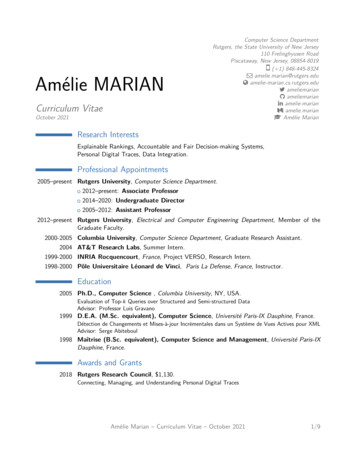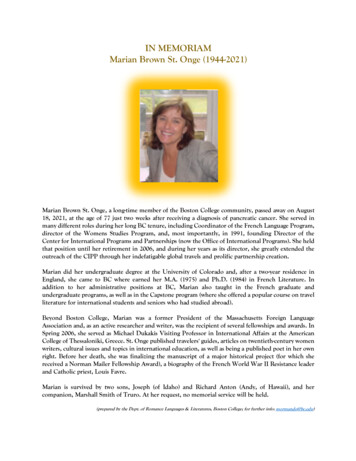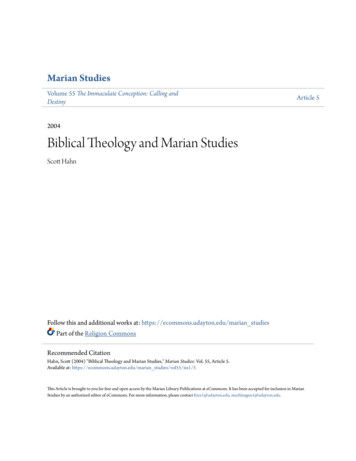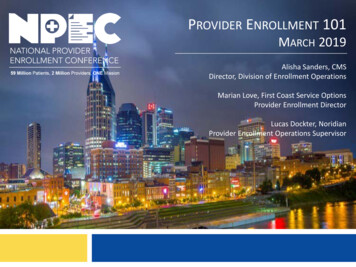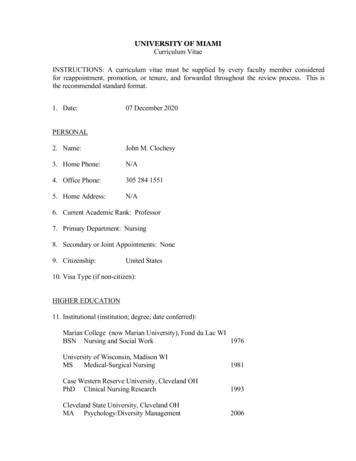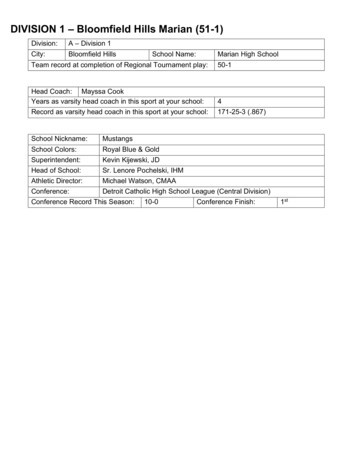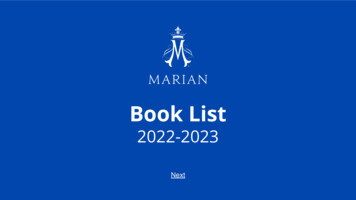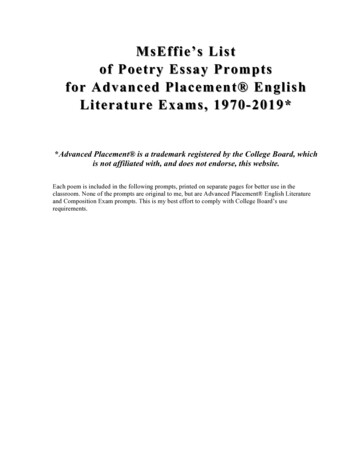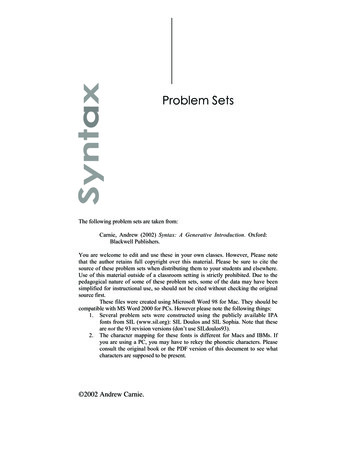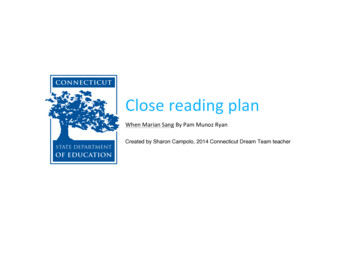
Transcription
d by Sharon Campolo, 2014 Connecticut Dream Team teacher
What makes this text complex?Text andAuthorWhen Marian Sang by Pam Munoz RyanWhen alSang by PamAnderson/dp/0439269679/ref sr 1 1?s books&ie UTF8&qid 1398542449&sr 1Munoz Ryan1&keywords when marian sangText DescriptionThis is a biographical text about famous African American musician Marian Anderson. It tells the story of her struggle to overcome prejudice and follow her dream ofbecoming a musician. After encountering numerous obstacles, she performs a concert for a mixed audience of 75,000 people in a “pre-Civil Rights America”, makinghistory. She eventually reaches her dream of singing in the opera. This lesson plan is written utilizing literary reading standards to allow students to further understandthe character and her personal struggle.Lexile and GradeLevel780L, Grade 4Meaning/Central IdeasMeaning and central idea of the text (overcoming enormousobstacles to pursue childhood dreams to fruition) is explicitlystated in the conclusion of the text and is reinforced throughexamples and context given throughout the text.Connecticut State Department of EducationTextLengthQuantitative2030QualitativeText Structure/OrganizationPicture book. Song lyrics are used throughout in context to enhance meaning. Events occur inchronological order. Some quotations are used. Italicized text is used to indicate a change inreader’s tone of voice.2
Prior Knowledge DemandsLanguage FeaturesUnderstanding of time period (early 1900s), prejudice andsegregation. Requires some specific knowledge of monumentsin Washington, DC and musical terminologydescriptive adjectives and phrases, rhetorical questions, figurative language included in song lyricsVocabularyTier Two Words (General academic vocabulary)Tier Three Words (Domain-specific words)“Words that are far more likely to appear in written texts than in speech.[They] often represent subtle or precise ways to say relatively simplethings—saunter instead of walk, for example.” (CCSS ELA Appendix A)“[Tier Three words] are specific to a domain or field of study (lava, carburetor, legislature, circumference, aorta)and key to understanding a new concept within a text.” (CCSS ELA Appendix A) velvetydistincttragedyprejudiceunwaveringmomentous narrow-mindedhumiliationopulenttrepidationtuition duetharmonycontraltooperaorchestra accompanistnegroesconductoraccompanistPotential Reader/Task ChallengesStudents may have difficulty decoding the text. This may need to be presented as a read aloud. Students may lack background knowledge of the time period (prejudiceand segregation). This may need to be pre-taught. Students may have difficulty with Tier III words without video and audio support to further understanding. AttachedPower Point can be used to provide concrete examples of Tier III words.Connecticut State Department of Education3
Connecticut State Department of Education4
Connecticut State Department of Education5
Connecticut State Department of Education6
Connecticut State Department of Education7
Connecticut State Department of Education8
Connecticut State Department of Education9
Connecticut State Department of Education10
Connecticut State Department of Education11
Text-dependent questionsStandard alignmentPage of thisdocumentStandardRL.4.1#13StandardRL 4.3, RL 4.1#22TDQ #3 In the text the author uses song lyrics to convey Marian’s struggles and the faith that she holds onto throughouther struggles. What does the author mean when she includes the lyrics,“He’s got the wind and the rainin His handsHe’s got the sun and the moonright in His handsHe’s got the wind and the rainin His handsHe’s got the whole world in His hands”?StandardRL 4.4, RL 4.1#31TDQ #4 Think about the specific challenges and barriers Marian faced in the text. What inferences can you make aboutsocietal views of African American people in the early 1900s?StandardRL 4.1#36TDQ #5 Which key details does the author use to support the themes of perseverance and prejudice throughout the text?Use specific examples to summarize the text.StandardRL 4.2, 4.1#46QuestionTDQ #1 Refer to details and examples that the author provides to explain Marian’s passion for music and tell how thisinformation informs you about what Marian wants to do as a career.TDQ #2 Identify two events which were barriers to Marian’s singing career. Describe one event in depth and explainhow it got in the way of her pursuit to become a professional singer, drawing on specific evidence from the text.Target Standards RL.4.1 Refer to details and examples in a text when explaining what the text says explicitly and when drawing inferences from the text.RL 4.2 Determine a theme of a story, drama, or poem from details in the text; summarize the text.RL.4.3 Describe in depth a character, setting, or event in a story or drama, drawing on specific details in the text. (e.g., a character’s thoughts, words, or actions)RL.4.4 Determine the meaning of words and phrases as they are used in a text, including those that allude to significant characters found in mythology. (e.g.,Herculean)Connecticut State Department of Education12
Question 1Question #1Standard(s)covered:TDQ #1 Refer to details and examples that the author provides to explain Marian’s passion for music and tell how this information informsyou about what Marian wants to do as a career.RL 4.1 Refer to details and examples in a text when explaining what the text says explicitly and when drawing inferences from the text.Example response that meets standardThroughout the text When Marian Sang by Pam Munoz Ryan, the author showsMarian’s continuous passion for music by explaining that when Marian sang she wouldclose her eyes as if “finding the music within” herself. She became so involved with themusic when she was singing that the audience felt her emotions, too. She made themfeel her “spirited worship, tender affection and joy” when she sang. This shows thatsinging gave her strong emotions and that she really enjoyed singing. The author alsosays that Marian didn’t need any encouragement to sing, and that she thought musicwas serious business. When she was singing in her choir, she learned her part of thesong and she also learned all the other parts too. She hoped to go to music schoolsomeday, and since she knew it was expensive and her family didn’t have a lot ofmoney, she would need to raise the money from people in her church. This informationshows that she felt so strongly about music that she wanted to learn as much as shecould about it. She was also willing to work hard to raise the tuition money she wouldneed to go to college and become an even better musician. This makes me think thatshe is committed enough to music to make it her career.Look-fors Refers to evidence and examples from the text that showMarian has a strong passion for music.States an inference as to what Marian wanted to do for hercareer.Refers to evidence and examples from the text as support toshow that Marian wanted to sing for a career.If students are struggling to answer the text-dependent question, use this follow-up plan for modeling and practice:ObjectivePriorknowledge toreviewIn this lesson you will learn how to refer to explicit details and examples in a text to answer a text dependent question by reading andannotating the text and making inferences to explain what the author is saying.Students need to be able to ask and answer questions to demonstrate an understanding of the text and be able to refer to the text as abasis for the answers.Connecticut State Department of Education13
Steps toachieveobjectiveThink aloud for direct instruction 1) Ask yourself,“What is thisquestion askingme to do?” 2) Determinewhat words andphrasesdemonstratethe character’sfeelings.3) Ask yourself“What do thesewords andphrases tell meabout thecharacter’sgoals?” I wonder what words in this question are really important. I’m going to reread the question and underline the words that tell mewhat to look for in the text. It says, “Refer to details and examples that the author provides to explain Marian’s passion for musicand tell how this information informs you about what Marian wants to do as a career.”First I notice that it wants me to refer to details and examples from the text, so that means I should reread while annotating the text.Next, I notice that it wants me to find the words and phrases that show me that Marian is passionate about music. Hmmm I knowthat the word passionate means to have really strong feelings about something, so this means that I need to look for the words andphrases the author used to show Marian has really strong feelings about music.Lastly I see that it wants me to use that information to figure out what she wants to do for her career. I know that the word careermeans what people do for work, so I need to use what I read to figure out what Marian would like her job to be as an adult.I’m going to reread the first page with my pencil handy and underline any words or phrases that show me Marian has strongfeelings about music. In the first sentence I see that it says “Marian loved to sing”. I’m going to underline that and circle the word“sing”. This way I can find this sentence quickly when I am going back to write my answer. On the next page I notice that Marianhas her eyes closed in the picture as she is singing. The author also says that Marian often sang with her eyes closed “as if findingthe music within”. This really shows that she has strong emotions about singing, so I am going to underline that too. I’m also goingto underline where the author said Marian thought music was “serious business” and that she went to apply to “music school”.Wow! I found a lot of places in the text where Marian was showing she had a lot of passion for music! Before I continue, I’ll writeall of the words and phrases I have found on the white board. I found the phrases “loved to sing”, “finding the music within”,“serious business” and “music school”. These words show me that Marian is passionate about singing.Now that I know how much Marian likes to sing, I can use that to help me figure out what she wants to do for a career.I notice on my white board that Marian wanted to go to music school. I know that when people go to a school to learn about aparticular topic, it is usually for college. People usually choose to study the topic that they want to get a job in. This makes methink that Marian wants to be a singer when she grows up.Connecticut State Department of Education14
4) Write theanswer to thequestionsincludingevidence fromthe text assupport. Now that I have finished organizing my thoughts, I can write my answer. I can start my answer with something like this,“Throughout the book, the author showed that Marian had a strong passion for music.”Now I need to find details from the text to support my answer. Here it says that Marian “loved to sing.” That shows me that shefeels strongly about singing. I’m going to write that as my first supporting detail. Next, I see that I wrote she closed her eyes whenshe was singing as if she was “finding the music within.” That really shows that she has a strong emotional reaction to singing. I’mgoing to include that to strengthen my answer and then I am going to explain in my own words that finding the music within meansthat she felt so strongly about it that she made a connection to it within herself. I also wrote that she thought music was “seriousbusiness.” I’m going to write that too and then write a sentence that explains that if she thought music was serious business thenshe felt very strongly about its importance.I have a lot of information to show that Marian was passionate about singing. Now I need to find an example that shows that shewanted to make singing her career. I see that I wrote down that she went to apply to “music school.” I remember from the bookthat the people from her church promised they would pay for her tuition if she was accepted. I am going to write that in my answertoo and then explain that if she wanted to go to school to learn about music badly enough that she would take money from thepeople at her church, she must really want to be a singer when she is an adult.Extension and practice If students are struggling to find words that show Marian’s passion, ask them to look at the illustrations and identify a clue in the image that Marianwas feeling passionate. Next give them three quotes from the book, making sure that one of them includes information that shows Marian ispassionate. Ask students to choose the quote that shows she is passionate and explain it in their own words.If students are struggling to find evidence from the text, give them a T-chart graphic organizer. On one side write “Shows Marian’s Passion” and onthe other side write “What Marian Wants to Do for Her Career”. Provide students with highlighting tape. Ask them to use the highlighting tape toidentify quotes that show Marian’s passion or give a clue as to what she would like to do for a career. Once they have highlighted the examples theycan transfer it to the T-chart. See attachments.For students that need this assignment modified to a much simpler level, provide these students with a T-chart (on one side write “Shows Marian’sPassion” and on the other side write “What Marian Wants to Do for Her Career”) and examples from the text printed onto strips of paper. Askstudents to place the paper strips in the correct category and then ask them to orally explain why they placed them where they did and how it supportstheir ideas. See attachments.Connecticut State Department of Education15
What next?For additional practice, with students or for students' independent work,apply this learning objective and set of steps to other literary texts toteach using details and examples from a text as support. (RL.4.1)See more examples of how to teach how to accurately reference details andexamples from a text (RL 4.1)Objective: Refer to explicit details and examples in a text to answer a textdependent question by reading and annotating the text and makinginferences to explain what the author is saying.Draw inferences about what a character is thinking by examiningdialogue1. Ask yourself, “What keywords should I look for in the text?”2. Reread with a pencil and underline words and phrases that will helpyou answer the question.Use the title of a poem to guide your readingDraw inferences about what a character is thinking by examiningdialogue3. Ask yourself, “What does this tell me about where the story isheaded?”4. Explain your answer referring to information from the text.Connecticut State Department of Education16
Connecticut State Department of Education17
Connecticut State Department of Education18
Connecticut State Department of Education19
Connecticut State Department of Education20
Question 2Question #2Standard(s)covered:TDQ #2 Identify two events which were barriers to Marian’s singing career. Describe one event in depth and explain how it got in the way ofher pursuit to become a professional singer, drawing on specific evidence from the text.RL.4.3 Describe in depth a character, setting, or event in a story or drama, drawing on specific details in the text (e.g., a character’s thoughts,words, or actions)RL.4.1 Refer to details and examples in a text when explaining what the text says explicitly and when drawing inferences from the textExample response that meets standardMarian faced many challenges as she tried to start her singing career. She was unableto apply for college because colleges did not accept colored people. This stopped herfrom going to college to learn as much as she could about music. Instead, she neededto learn from taking voice lessons in her neighborhood. Another barrier that she facedwas being turned away from performing at Constitution Hall. Americans were soprejudiced against black people that they would only let white people sing there. Theytold Marian that the hall was not available the day of her performance and they had noother dates for her to sing there because of their “white performers only” policy. Thishappened shortly after she felt a lot of success in Europe, where she was allowed tosing at many different places to large audiences who loved her. One of Sweden'snewspapers even wrote about “Marian Fever”. When Marian was turned away fromConstitution Hall she tried to move the performance to a large auditorium at an all-whitehigh school but was not allowed to sing there either. The prejudice that white peopleshowed toward black people was keeping her from singing to an audience in America.This was a huge barrier for her because if she wanted to sing she would need to find aplace to perform and a way for people to hear her sing.Look-fors Identifies two events that were barriers to Marian’s singingcareer.Explains how the events were barriers.Describes one of the barriers in depth.Refers to specific evidence from the text as support.If students are struggling to answer the text-dependent question, use this follow-up plan for modeling and practice:ObjectiveIn this lesson you will learn how to describe an event in depth by drawing on specific details from the text to explain what the text says.Priorknowledge toreviewStudents must be able to ask and answer questions from the text to demonstrate an understanding of the text and be able to refer to thetext as a basis for the answers. Students must also be able to describe characters in a story (their traits, motivations or feelings) andexplain how their actions contribute to the sequence of events.Connecticut State Department of Education21
Steps toachieveobjectiveThink aloud for direct instruction 1) Ask yourself,“What is thisquestion askingme to do?” 2) Determinewhatchallenges thecharacter facedin the text. 3) Useinformationfrom the text toanalyze howthe challengesin the textaffected thecharacter. Hmmm I wonder what words in the question are really important for me to focus on. I notice that it wants me to look for twobarriers that Marian encountered when pursuing her career. I know the word barrier means a challenge that got in her way. I alsoknow she wanted to be a singer, so I am looking for events that got in the way of her trying to become a singer. I’m going tounderline the words “two barriers” to remind myself what I am looking for.I see that it also wants me to describe one of the barriers in depth. I’m going to underline the words “in depth”. That tells me that Iam going to need to really understand how this barrier affected Marian and how it got in the way of her dream.Next I notice that it wants me to use specific examples. I’m going to underline the word “examples” to remind me to really focus ondetails from the text that support my thoughts.Now I need to figure out what some of the barriers were that stood between Marian and her singing career. I’m going to annotateby putting the text under the document camera and underlining the barriers that I find in the text so I can see them on the SmartBoards. By annotating, I will be able to find this information easily when it is time for me to write my response. (Teacher can usepost-it notes on the text or annotate on photocopies of the text if a Smart Board and document camera are not available)First, I see that Marian could not apply for college because of the college's “whites only” policy. I’m going to underline that. Next Inotice that the text said Marian had to sing to “separate” or “segregated" audiences. I’m going to underline that. I also read thatMarian was able to sing all over Europe, but when she tried to perform at Constitution Hall, she was told that she couldn’t becauseshe was African American. I am going to underline that as well.Looking at my list of barriers, I think the one that was the biggest barrier for Marian was not being able to sing at Constitution Hall. Iam going to really focus on that one. For my second barrier I think I will focus on her being unable to go to music school. I thinkthat shows how she faced challenges from the start of her career.I’m going to start by rereading the page that talks about Marian’s success in Europe. I notice that it talks about people having“Marian Fever” and coming to see her sing. She was singing in many different places and felt successful. I’m going to underlinethe words “Marian Fever”. These words really show me that other parts of the world were very accepting of Marian and loved herbeautiful voice. This makes me think that many people would love to hear Marian sing so she should be able to find lots of placesthat would want her to perform once she comes back to the United States.Now I’m going to reread the page that discusses Marian trying to sing at Constitution Hall, and I’m going to annotate importantinformation on that page. I read that Marian’s performance there was canceled, and that they could not reschedule because oftheir “white performers only policy”. I am going to underline that. Next, Marian tried to sing at a white high school but, they alsotold her that she could not sing there because she was black. I’m going to underline that too. This really tells me that Marian wastrying hard to perform for people, and couldn’t find a place that would allow her to sing because of her skin color, even though shewas successful in Europe. I am thinking the prejudice people have against her skin color is really standing in her way of becominga singer. It will be really hard for her to become a singer if she cannot find places to perform.Connecticut State Department of Education22
4) Write theanswer to thequestionsincludingevidence fromthe text assupport. Now that I have finished talking about my thoughts and annotating the text, I can write my answer. I can start by writing somethinglike this, “There were many barriers that stood in the way of Marian becoming a singer.”Next, I can include the two barriers that I found in the text. First, I’m going to write about Marian trying to go to college and learnmore about music but being turned away because they did not take African American people at their school. I know that people goto college to study what they want to do for a job, so I can infer that Marian being told she could not go to college to study musicwould make it harder for her to get really good at singing and make it her career. I’m going to write that to really explain my thinkingabout the evidence I found in the text.The author also wrote about how Marian went to Europe and was very successful. People loved her singing so much they called it“Marian Fever”, but when she came back to America she couldn’t find a place to sing because of the whites only policies of concerthalls and schools with large auditoriums. I’m going to include that example from the text because that was a large barrier to hercareer. I know the question asks me to describe one event in depth so I am going to make sure I include the details about how shetried to sing at Constitution Hall and the high school. I want to make sure I explain my thinking very well, so I’m going to include asentence that explains that many people in Europe loved her beautiful voice and wanted to hear her sing, but once she came backto the United States, many people were prejudice against her skin color so she could not sing. This was a large barrier to hercareer because she needed an audience in order to become a successful singer. I’m going to write that too.Now I’m going to reread my response and make sure that I have answered the question and really explained my thinking.Extension and practice If students are struggling identifying the barriers, provide them with a timeline. They can fill in important events in the story as they reread or listen tothe teacher reread. After their time line is filled in, ask them to circle the events that seemed to be barrier to Marian’s career. If this is still difficult forthem, the teacher can give them a timeline that is already filled in and then students can circle the information. If students are having difficulty supporting their ideas with textual evidence, provide students with a graphic organizer in which they can write thebarrier, the evidence for the text and an explanation in their own words as to why that was a barrier. If an extension activity is needed, students can return to the text and identify an additional barrier that Marian faced. They can use evidence from thetext to support why that served as a barrier to her career, and compare the barriers to determine which were the least and most challenging.Connecticut State Department of Education23
What next?For additional practice, with students or for students' independent work,apply this learning objective and set of steps to other literary texts toteach describing an event in depth by using details and examples from atext as support. (RL.4.1, RL. 4.3)Objective: Describe an event in depth, drawing on specific details from thetext to explain what the text says.See more examples of how to teach referring to details and examples in atext and describing an event from a story in depth.Identify the narrator in a story1.Ask yourself, “What should I look for in the text?”Track the setting in a story2.Reread while annotating, looking for words and phrases that willhelp you answer the question.Develop ideas about characters by tracking their actions and feelings3.Ask yourself, “How does this event add to the understanding of thestory?”4.Explain your answer, referring to information from the text.Describe an event using a character's words and actionsConnecticut State Department of EducationIdentify cause and effect of events in a story by examining acharacter's actions24
Connecticut State Department of Education25
Connecticut State Department of Education26
Connecticut State Department of Education27
Connecticut State Department of Education28
Connecticut State Department of Education29
Connecticut State Department of Education30
Question 3Question #3Standard(s)covered:TDQ #3 In the text the author uses song lyrics to convey Marian’s struggles and the faith that she holds onto throughout her struggles. Whatdoes the author mean when she includes the lyrics,“He’s got the wind and the rainin His handsHe’s got the sun and the moonright in His handsHe’s got the wind and the rainin His handsHe’s got the whole world in His hands”?RL.4.4 Determine the meaning of words and phrases as they are used in a text, including those that allude to significant characters found inmythology. (e.g., Herculean)RL.4.1 Refer to details and examples in a text when explaining what the text says explicitly and when drawing inferences from the text.Example response that meets standardWhen the author uses the lyrics, “He’s got the wind and the rain in His hands, He’s gotthe sun and the moon right in His hands,” she is trying to show that, although Marianfelt her dream of becoming a singer was not something that she could achieve, it waspossible. The author used these lyrics after stating that Marian’s dream of singing inthe opera was “simply the sun and the moon- a dream that seemed too far away toreach”. Marian felt as if being an African American opera singer was not a dream thatshe would ever be able to achieve. The song lyrics talk about holding wind, rain, thesun and the moon in “His” hands. The word “His” is referring to her God. The lyricsshow that while she feels her dream is something she cannot grasp, she believes thather God can hold the sun, moon, wind and rain in His hands. These are not things thatcan be literally held in someone’s hands; however, the author uses them as symbols toshow that Marian can reach her dream as long as she does not lose faith. The authorchose these lyrics to show the things that seem out of your grasp can be achieved.Connecticut State Department of EducationLook-fors Explain the meaning of the lyrics in relation to the text.Use details and examples from the text to explain the answer.Explains how the song lyrics show Marian’s feelings that herdream is beyond her reach.Explains how the song lyrics convey Marian’s faith.31
If students are struggling to answer the text-dependent question, use this follow-up plan for modeling and practice:ObjectivePriorknowledge toreviewIn this lesson you will learn to determine the meaning of words and phrases that are used in a text by reading and annotating the text andusing details and examples to support your answers.Students must be able to ask and answer questions from the text to demonstrate an understanding of the text and be able to refer to thetext as a basis for the answers. Students must also be able to determine the meaning of words and phrases as they are uses in a text,distinguishing literal from nonliteral language.Steps toachieveobjectiveThink aloud for direct instruction 1) Ask yourself,“What is thisquestion askingme to do?” 2) Determinewhich wordsand phrasesare important. I’m going to reread this question and ask myself, “What words in the question are important for me to focus on?” The questionsays, “In the text the author uses song lyrics to convey Marian’s struggles and the faith that she holds onto throughout herstruggles. What does the author mean when she includes the lyrics, “He’s got the wind and the rain in His hands, He’s got the sunand the moon right in His hands, He’s got the wind and the rain in His hands, He’s got the whole world in His hands”? I see thatthe question is asking me to really look at these song lyrics. I’m going to underline the word “lyrics”.I also notice that the question is asking me to explain how the lyrics show how Marian struggled and how she held onto her faiththroughout her struggles. I’m going to underline the words “struggles” and “faith” to remi
Wow! I found a lot of places in the text where Marian was showing she had a lot of passion for music! Before I continue, I'll write all of the words and phrases I have found on the white board. I found the phrases "loved to sing", "finding the music within", "serious business" and "music school".
